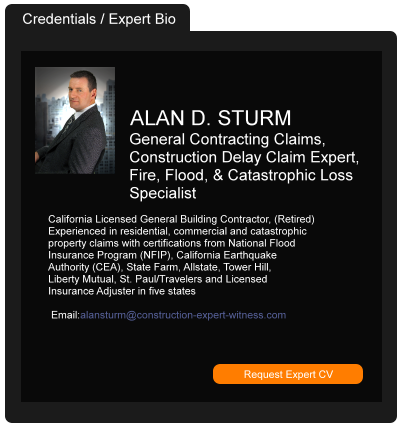Iowa Apartment Complex Owners Awarded Millions for Building Defects
March 31, 2014 —
Beverley BevenFlorez-CDJ STAFFThe owners of a West Des Moines, Iowa apartment complex received an award of $12.4 million by a Polk County jury, according to The Des Moines Register, who declared that “[i]t’s believed to be one of the largest judgments of its kind in state history.” The owners had sued the builders “over leaks and mold the owners said took years to correct.”
The verdict “marked the culmination of a nearly decade-long saga involving the construction of the Westlake apartments and condos, a 300-unit complex built at 1770 92nd St. on the Dallas County side of West Des Moines during the pre-recession housing boom.”
Attorney Steve Eckley told The Des Moines Register that “the settlement covers about $3 million in previous repairs, about $6 million in expected repairs and maintenance and about $6 million in lost revenue.”
Read the court decisionRead the full story...Reprinted courtesy of
N.J. Appellate Court Confirms that AIA Construction Contract Bars Insurer's Subrogation Claim
September 10, 2019 —
Saxe Doernberger & Vita, P.C.On April 4, 2019, the Appellate Division of the New Jersey Superior Court confirmed that the waiver of subrogation provision in a commonly used form construction contract, American Institute of Architects (AIA) form A201 — 2007 General Conditions of the Contract for Construction, precluded an insurer’s claims against a subcontractor.
In Ace American Ins. Co. v. American Medical Plumbing, Inc., the court considered Ace American Insurance Company’s (Ace) subrogation claim against a plumbing subcontractor who was allegedly responsible for a water main leak that caused approximately $1.2 million in damages to Ace’s insured, Equinox Development Corporation (Equinox).
In March 2012, Equinox entered into a contract with Grace Construction Management Company, LLC (Grace) to build the “core and shell” of a new health club. Equinox and Grace used AIA form A201 for their contract. Grace then hired American Medical Plumbing, Inc. (American) as a plumbing subcontractor for the project. In April 2013, the water main failed, flooding the health club.
Read the court decisionRead the full story...Reprinted courtesy of
Saxe Doernberger & Vita, P.C.Saxe Doernberger & Vita, P.C. may be contacted at
coverage@sdvlaw.com
A Quick Virginia Mechanic’s Lien Timing Refresher
February 27, 2023 —
Christopher G. Hill - Construction Law MusingsAs those who read Construction Law Musings on a regular basis know,
mechanic’s liens are a big part of my construction law practice. These
tricky and strictly enforced statutory collection tools are very powerful when correctly recorded and utterly useless if they aren’t recorded in a timely fashion and with the correct information contained within them. Couple that fact with recent
changes to the mechanic’s lien form in 2019, and I feel the need to give a quick refresher.
If you’ve kept up with Musings, you know about the two big numbers for Virginia mechanic’s lien timing, 90 and 150. These should be kept in mind for every general contractor, subcontractor, or supplier on any construction project in Virginia.
Virginia Code Section 43-4 sets out the reasons to keep these numbers in mind. The code section sets out why you need to know these numbers.
The 90 refers to the deadline for recording a lien. This number affects the right to a lien in Virginia. In order to preserve lien rights, a construction contractor must record the lien within ninety days of the last day of the last month in which the last work was performed or no later than ninety days from the date of completion of the project or other termination of work. The short version is that most general contractors on commercial projects have 90 days from the last work in which to record their lien and most subcontractors have 90 days from the last day of the last month of work. However, the best practice is to simply calculate the 90 days from the last work performed or material supplied to avoid issues and arguments between attorneys regarding timing.
Read the court decisionRead the full story...Reprinted courtesy of
The Law Office of Christopher G. HillMr. Hill may be contacted at
chrisghill@constructionlawva.com
Lenders Facing Soaring Costs Shutting Out U.S. Homebuyers
October 29, 2014 —
Alexis Leondis and Clea Benson – BloombergClem Ziroli Jr.’s mortgage firm, which has seen its costs soar to comply with new regulations, used to make about three loans a day. This year Ziroli said he’s lucky if one gets done.
His First Mortgage Corp., which mostly loans to borrowers with lower FICO credit scores and thick, complicated files, must devote triple the time to ensure paperwork conforms to rules created after the housing crash. To ease the burden, Ziroli hired three executives a few months ago to also focus on lending to safe borrowers with simpler applications.
“The biggest thing people are suffering from is the cost to manufacture a loan,” said Ziroli, president of the Ontario, California-based firm and a 22-year industry veteran. “If you have a high credit score, it’s easier. For deserving borrowers with lower scores, the cost for mistakes is prohibitive and is causing lenders to not want to make those loans.”
Reprinted courtesy of
Alexis Leondis, Bloomberg and
Clea Benson, Bloomberg
Ms. Leondis may be contacted at aleondis@bloomberg.net; Ms. Benson may be contacted at cbenson20@bloomberg.net
Read the court decisionRead the full story...Reprinted courtesy of
Does a No-Damage-for-Delay Clause Also Preclude Acceleration Damages?
January 27, 2020 —
Ted R. Gropman & Christine Z. Fan - ConsensusDocsConstruction contracts often include a “no damage for delay” clause that denies a contractor the right to recover delay-related costs and limits the contractor’s remedy to an extension of time for noncontractor-caused delays to a project’s completion date. Depending on the nature of the delay and the jurisdiction where the project is located, the contractual prohibition against delay damages may well be enforceable. This article will explore whether an enforceable no-damage-for-delay clause is also a bar to recovery of “acceleration” damages, i.e., the costs incurred by the contractor in its attempt to overcome delays to the project’s completion date.
Courts are split as to whether damages for a contractor’s “acceleration” efforts are distinguishable from “delay” damages such that they may be recovered under an enforceable no-damage-for-delay clause. See, e.g., Siefford v. Hous. Auth. of Humboldt, 223 N.W.2d 816 (Neb. 1974) (disallowing the recovery of acceleration damages under a no-damage-for-delay clause); but see Watson Elec. Constr. Co. v. Winston-Salem, 109 N.C. App. 194 (1993) (allowing the recovery of acceleration damages despite a no-damage-for-delay clause). The scope and effect of a no-damage-for-delay clause depend on the specific laws of the jurisdiction and the factual circumstances involved.
There are a few ways for a contractor to circumvent an enforceable no-damage-for-delay clause to recover acceleration damages. First, the contractor may invoke one of the state’s enumerated exceptions to the enforceability of the clause. It is helpful to keep in mind that most jurisdictions strictly construe a no-damage-for-delay clause to limit its application. This means that, regardless of delay or acceleration, courts will nonetheless permit the contractor to recover damages if the delay is, for example, of a kind not contemplated by the parties, due to an unreasonable delay, or a result of the owner’s fraud, bad faith, gross negligence, active interference or abandonment of the contract. See Tricon Kent Co. v. Lafarge N. Am., Inc., 186 P.3d 155, 160 (Colo. App. 2008); United States Steel Corp. v. Mo. P. R. Co., 668 F.2d 435, 438 (8th Cir. 1982); Peter Kiewit Sons’ Co. v. Iowa S. Utils. Co., 355 F. Supp. 376, 396 (S.D. Iowa 1973).
Reprinted courtesy of
Ted R. Gropman, Pepper Hamilton LLP and Christine Z. Fan, Pepper Hamilton LLP
Mr. Gropman may be contacted at gropmant@pepperlaw.com
Read the court decisionRead the full story...Reprinted courtesy of
Client Alert: Naming of Known and Unknown Defendants in Initial Complaints: A Cautionary Tale
September 24, 2014 —
R. Bryan Martin & Whitney L. Stefko – Haight Brown & Bonesteel LLPOn September 12, 2014, the Ninth Circuit Court of Appeals, in Butler v. National Community Renaissance of California, upheld a district court's dismissal of certain defendants named in amended complaints, affirming the necessity of naming those known and unknown defendants in Plaintiff's original complaint.
In April 2009, Plaintiff Zina Butler filed an action in federal district court, naming a single defendant, National Community Renaissance Corporation ("National"), for an alleged warrantless search of Plaintiff's apartment on April 18, 2007. The single page complaint asserted that the apartment manager provided a Section 8 investigator, a City employee and Sherriff deputies keys to Plaintiff's apartment and conducted a search in violation of her Fourth Amendment rights. Shortly after, Plaintiff filed a first amended complaint, with the only change being the addition of defendant, the Housing Authority of the County of Los Angeles ("HACoLA") in the caption. In May 2009, the court (on its own accord) dismissed the first amended complaint with leave to amend as "it [was] unclear whom Plaintiff intend[ed] to sue."
In June 2009, Plaintiff filed a second amended complaint, identifying National and HACoLA in the caption as defendants, but separately identifying several other individuals and entities allegedly involved in the incident occurring in April of 2007 in the complaint's statement of facts. The Court, once again, dismissed the second amended complaint with leave to amend for the same reasons it dismissed Plaintiff's first amended complaint.
Reprinted courtesy of
R. Bryan Martin, Haight Brown & Bonesteel LLP and
Whitney L. Stefco, Haight Brown & Bonesteel LLP
Mr. Martin may be contacted at bmartin@hbblaw.com; Ms. Stefko may be contacted at wstefko@hbblaw.com
Read the court decisionRead the full story...Reprinted courtesy of
No One to Go After for Construction Defects at Animal Shelter
January 28, 2013 —
CDJ STAFFThe Riverside County Animal Shelter in Thousand Palms has had problems since it opened in 2006, including floors that weren't able to withstand scratching by dogs and a malfunctioning HVAC system. The county's expenses only started with the $6.9 million cost of building the shelter, as the building has required almost constant repairs. Riverside County Supervisor John Benoit said that "there were shortcomings in the construction that became apparent later."
The County can't sue, because the builder closed operations after a bankruptcy. "There's no one to go after," said Benoit.
Read the court decisionRead the full story...Reprinted courtesy of
How California’s Construction Industry has dealt with the New Indemnity Law
October 22, 2014 —
Mark S. Himmelstein, Esq. - Newmeyer & DillionIt has been almost two years since the California legislature enacted changes to the state’s indemnity law affecting commercial construction contracts. Although we do not yet have any court opinions analyzing the new statutes, the attorneys at
Newmeyer & Dillion now have real world experience in negotiating such indemnity provisions. It is time to evaluate how the construction community has reacted to the changes. In this article, we examine the practical applications of the new law to various construction agreements.
Enacted on January 1, 2013, the new legislation was the latest in a series of efforts by subcontractors and their insurers to eliminate “Type I” indemnity clauses. Under a Type I provision, a subcontractor has a duty to indemnify the developer or general contractor for the negligence of the developer or general contractor or other subcontractors, in addition to the negligence of the subcontractor itself. In 2006, the law was changed to preclude Type I provisions regarding “For Sale” residential construction defect claims. At that time, there was no such restriction enacted for commercial construction contracts. However, since then, commercial subcontractors have been seeking similar legislation. Their efforts culminated in the 2013 revisions regarding commercial contracts.
Commercial Subcontracts
Pursuant to the new indemnity statute — Civil Code section 2782.05 — we have revised our clients’ commercial subcontracts to:
(a) Eliminate the requirement that the subcontractor indemnify the general contractor for the general contractor’s “active negligence;” and
(b) Include the subcontractor’s options for defending claims for which they have an indemnity obligation.
Many subcontractors have responded: “Hey, wait a minute, the new legislation eliminated Type I indemnity so you (general contractor) cannot still require any indemnification for the general contractor’s negligence”. Well, that might be the rumor in subcontractor circles, but the new statute does not eliminate indemnity for the general contractor’s passive fault. In addition, the Civil Code lists 13 instances where the new indemnity restrictions do not apply.
Residential Subcontracts
The legislature did not make anyone’s job easier by drafting a different indemnity provision for commercial subcontracts than for residential subcontracts. In fact, the residential and commercial statutes are different in several critical respects. First, the restrictions on indemnity in the residential statute apply only to construction defect claims in newly constructed “For Sale” houses. The statute does not preclude Type I indemnity provisions for any other claims arising out of residential subcontracts. In contrast, the indemnity restrictions in the commercial statute apply to all claims arising out of commercial subcontracts. In addition, the commercial statute allows indemnity for the general contractor’s passive fault. Since some subcontractors on “residential” projects perform off-site “commercial” work as well, we have amended even residential subcontracts to address the subcontractors’ various indemnity obligations for different parts of their work (e.g., residential work versus commercial work).
Owner-Contractor Agreements
The January 1, 2013 new indemnity provisions apply not only to subcontracts, but also to owner-contractor agreements. Civil Code section 2782(c)(1) precludes indemnity for an owner’s active negligence. Interestingly, the exclusions contained in Civil Code section 2782.05 for subcontracts do not apply, and the statute does not provide contractors with the option of defending claims set forth in the sections concerning subcontracts. Therefore, we have revised the indemnity provisions in owner-contractor agreements to exclude indemnity for the owner’s active negligence.
Design Professional Agreements
The 2007 revisions with respect to “For Sale” residential contracts (discussed above), and the 2013 revisions for commercial contracts do not apply to design professionals. The new indemnity statute concerning commercial subcontracts specifically excludes design professionals from the “anti-indemnity” benefits provided to subcontractors. Therefore, Type I indemnity provisions are fair game and can still be included in design professional contracts.
Conclusion
In sum, Civil Code sections 2782 et seq. now contain an increasingly complex framework for indemnity rules in construction contracts. For example, there is one set of rules for “For Sale” residential construction defect claims (no indemnity for the developer’s active or passive negligence), another for any other claims arising out of residential construction (Type I indemnity is permitted), another for commercial subcontracts (no indemnity for the general contractor’s active negligence, but indemnity for the general contractor’s passive negligence unless any of the exceptions apply, in which case Type I indemnity is permitted), and yet another for commercial owner contractor agreements (no indemnity for the owner’s active negligence, but indemnity for the owner’s passive negligence with no exceptions).
California’s indemnity laws are complex, and rumors as to the impact of the new legislation have made it even more difficult to negotiate these provisions. It is imperative that indemnity clauses in construction contracts clearly delineate the obligations for the specific type or types of work contemplated by the contract. The legislature’s attempt to simplify indemnity obligations has actually made such provisions lengthier and more cumbersome. As experienced construction attorneys, our task is to draft indemnity provisions that comply with the laws, address potential claims, and are understandable.
Mr. Himmelstein is a partner in the Newport Beach office of Newmeyer & Dillion and practices in the areas of construction, real estate, business and insurance litigation. He also specializes in drafting and negotiating construction and real estate contracts. Mark can be reached at mark.himmelstein@ndlf.com.
Read the court decisionRead the full story...Reprinted courtesy of


































































